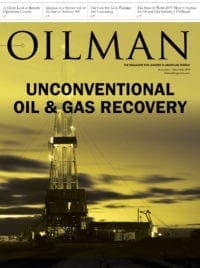Digital technologies have been a critical factor in the oil and gas industry’s transformation. Beyond transforming the industry, the integration of “smart” technologies now has the potential to create additional cost-savings from existing capacity. McKinsey research confirms how effective use of digital technologies can “reduce capital expenditures by up to 20 percent” while reducing operating costs “in upstream by 3 to 5 percent and by about half that in downstream.”
While integrating modern technologies isn’t a new phenomenon in the oil and gas sector, the advent of advanced sensing devices, and analytics from IoT and cloud services, offer significantly more data-driven, predictive maintenance possibilities. Recent research by the Swedish analyst firm Berg Insight predicted that the installed base of wireless IoT devices in the global oil and gas industry – at a CAGR (Compound Annual Growth Rate) of 6.8 percent – will reach 1.9 million units by 2023. The report sites remote monitoring of tanks and industrial equipment in the midstream and downstream as the most common applications for wireless solutions in the oil and gas industry.
With millions of physical devices connected to the Internet – from sensors, to equipment, to vehicles – collecting and sharing data across the devices, the avalanche of generated data from these devices must be captured. And the data must be transformed into comprehensible analytics to enable cost-effective preemptive operations and equipment maintenance to drive down operations cost, while increasing efficiency.
With distributed mission-critical facility operations across regions and continents, the oil and gas operators and executives must have holistic, real-time access and views across all their operations to prevent unforeseen risks. Tapping into digital technologies for advanced IoT analytics can not only contain operational costs, but allow for poised, data-driven business decisions.
As the McKinsey study underscores, assuring the most consistent up-time alone can reduce costs by up to 27 percent while also increasing energy efficiency by as much as 10 percent.
Crude IoT Data into Refined “Smart” Business Decisions
With IoT devices well integrated into all aspects of the oil and gas industry operations – from refinery to pipeline monitoring to worker safety to offshore rigging – operators have full access and holistic views into their operations and across all sites. For instance, sensors installed on oil tanks can help monitor and expedite maintenance issues before there are irreversible problems with the tank. Likewise, sensors on fiber optic cables can help map out oil exploration drilling sites to increase outputs without wasting time drilling in dry areas.
But keep in mind that billions of data points generated from these IoT devices are similar to crude oil – they are crude data. Only when the crude data is refined by collecting, organizing and delivering actionable analytics can they be valuable business intelligence tools. Only then can operators tap into the refined data to determine where operational tasks can be improved – from finding exact drilling sites, to increased productivity to ensured employee safety and more.
Facilities and sector operators can easily use interoperable IoT tools to empower existing advanced technologies and systems. They don’t need to overhaul their existing systems and sub-systems for new IoT connectivity.
Drilling into IoT Platforms Benefits
Edge IoT Platforms deployed at each site can seamlessly integrate into existing production and systems – without major configurations. There’s no need to bridge custom, development, programming, and proprietary technology. Its seamless integration into all existing systems quickly expedites data mining capabilities from all operations sites across regions and continents.
Operators can start collecting data from sensing systems to access a full portfolio of analytics of the data that can be refined for scalable deployment on and offshore.
With much of the oil and gas industry work conducted in far-to-reach spots, the IoT platforms can offer full visibility into hard-to-reach and monitor areas. Resolving connectivity issues – from tankers in middle of the ocean, to workers at far-reaching oil rigs to pipelines in the desert – allows operators to quickly detect problems or maintenance needs. Operators can swiftly mediate alerts and flag repairs before anything percolates into a major risk or disaster.
The IoT platforms can expedite provisions of appliances across various regions and distributed sites by collecting and organizing all data. The data can then be stored securely in a single, comprehensive, private data collection repository – and be easily accessible in the cloud. Once stored, the collected and organized data can be easily mined for analytics, UX tools and facility management applications using either existing in-house tooling, or through other cloud-based tooling available from a multitude of micro-service analytics and visualization providers.
The refined value of the data is gained with clear, actionable analytics that can help propel best business decision making. With real-time views of all the IoT devices connected across all the operational sites, oil and gas operators and executives can gain unprecedented access to:
- Gather real-time data and analytics from inaccessible sites – from offshore rigs to tankers – maintaining full control of operations and maintenance
- Expedite monitoring of refinery and pipeline systems – without having “boots on the ground” or “under the ground/oceans”
- Quickly resolve problems with preemptive measures – such as shut down or delay work to repair malfunctioning equipment or leaking pipes, etc. – before they erupt into major safety risks, PR nightmares and irreversible financial damage
- Unify separate monitoring systems, regardless of sub-systems, to gain sustainability and efficiency by reducing costly service/repair calls
- Tap advanced analytics to help reduce costs with predictive maintenance which the McKinsey report sites can decrease maintenance costs by up to 13 percent – not to mention gaining increased energy efficiency
- IoT data for improved customer service and customer relations and marketing strategy – by determining price-points that appeal to customers, or efficient supply chain management to improve “location planning and route optimization” as sited in the McKinsey report
Today’s IT-centric IoT ecosystem eliminates the legacy challenges of lack of visibility and access to valuable data from distributed sites. Now multi-site, distributed enterprises can quickly obtain collective monitoring without any disruptions to the efficiency of their existing subsystems.
Managing a portfolio of IoT connected, distributed mission-critical facilities with an IoT platform enables data mining for actionable analytics. Easily scalable across hundreds and thousands of distributed portfolio locations, the platform enables oil and gas operators to harness refined data to establish solid data-driven business decision advantages.
More critically, the oil and gas industry can alleviate its top three risks – economic, political and environmental – by utilizing the valuable refined actionable analytics. Failing to harness these advantages is a risk no enterprise can afford to take in today’s volatile business world.
Michael C. Skurla is the Chief Technology Officer ofRadix IoT– offering limitless monitoring and management rooted in intelligence–and has over two decades’ experience in control automation and IoT product design with fortune 500 companies. He is a contributing member of CABA, ASHRAE, IES Education, and USGBC and a frequent lecturer on the evolving use of analytics and emerging IT technologies to foster efficiency within commercial facility design.








